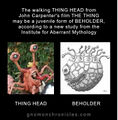Dungeons & Dragons (nonfiction): Difference between revisions
No edit summary |
No edit summary |
||
| Line 18: | Line 18: | ||
<gallery> | <gallery> | ||
File:Thing head and Beholder.jpg|link=Thing head and beholder theory|The '''[[Thing head and beholder theory]]''' posits that the walking Thing head from John Carpenter's film ''The Thing'' is a juvenile form of the Beholder from [[Dungeons & Dragons (nonfiction)|Dungeons & Dragons]]. | |||
File:Voronoi-diagram-color-commentators.jpg|link=Fantasy Voronoi diagram|1960: [[Nikolay Basov (nonfiction)|Nikolay Basov]] publishes guide to [[Fantasy Voronoi diagrams]], which will influence a generation of Dungeons & Dragons players. | File:Voronoi-diagram-color-commentators.jpg|link=Fantasy Voronoi diagram|1960: [[Nikolay Basov (nonfiction)|Nikolay Basov]] publishes guide to [[Fantasy Voronoi diagrams]], which will influence a generation of Dungeons & Dragons players. | ||
File:Polyhedral dice set.jpg|link=Polyhedral dice (nonfiction)|Squad of [[Polyhedral dice (nonfiction)|polyhedral dice]] ready to play some Dungeons & Dragons. | File:Polyhedral dice set.jpg|link=Polyhedral dice (nonfiction)|Squad of [[Polyhedral dice (nonfiction)|polyhedral dice]] ready to play some Dungeons & Dragons. | ||
</gallery> | </gallery> | ||
| Line 26: | Line 29: | ||
* [[Gnomon algorithm]] | * [[Gnomon algorithm]] | ||
* [[Gnomon Chronicles]] | * [[Gnomon Chronicles]] | ||
* [[Thing head and beholder theory]] - posits that the walking Thing head from John Carpenter's film The Thing is a juvenile form of the Beholder from Dungeons & Dragons | |||
* [[Scrimshaw abuse]] - falsely correlated with Dungeons & Dragons during the "Satanic scrimshaw" mania of the late 1970s and early 1980s. | |||
* [[Uncials]] | * [[Uncials]] | ||
| Line 36: | Line 41: | ||
* [[Saving Throw (game) (nonfiction)]] | * [[Saving Throw (game) (nonfiction)]] | ||
External links | == External links == | ||
* [https://en.wikipedia.org/wiki/Dungeons_%26_Dragons Dungeons & Dragons] @ Wikipedia | * [https://en.wikipedia.org/wiki/Dungeons_%26_Dragons Dungeons & Dragons] @ Wikipedia | ||
Revision as of 03:44, 5 October 2020
Dungeons & Dragons (abbreviated as D&D or DnD) is a fantasy tabletop role-playing game (RPG) originally designed by Gary Gygax and Dave Arneson, and first published in 1974 by Tactical Studies Rules, Inc. (TSR).
The game has been published by Wizards of the Coast (now a subsidiary of Hasbro) since 1997. It was derived from miniature wargames with a variation of the Chainmail game serving as the initial rule system.
D&D's publication is commonly recognized as the beginning of modern role-playing games and the role-playing game industry.
D&D departs from traditional wargaming and assigns each player a specific character to play instead of a military formation. These characters embark upon imaginary adventures within a fantasy setting.
A Dungeon Master serves as the game's referee and storyteller, while also maintaining the setting in which the adventures occur and playing the role of the inhabitants.
The characters form a party that interacts with the setting's inhabitants (and each other).
Together they solve dilemmas, engage in battles and gather treasure and knowledge.
In the process the characters earn experience points to become increasingly powerful over a series of sessions.
In the News
The Thing head and beholder theory posits that the walking Thing head from John Carpenter's film The Thing is a juvenile form of the Beholder from Dungeons & Dragons.
1960: Nikolay Basov publishes guide to Fantasy Voronoi diagrams, which will influence a generation of Dungeons & Dragons players.
Squad of polyhedral dice ready to play some Dungeons & Dragons.
Fiction cross-reference
- Gnomon algorithm
- Gnomon Chronicles
- Thing head and beholder theory - posits that the walking Thing head from John Carpenter's film The Thing is a juvenile form of the Beholder from Dungeons & Dragons
- Scrimshaw abuse - falsely correlated with Dungeons & Dragons during the "Satanic scrimshaw" mania of the late 1970s and early 1980s.
- Uncials
Nonfiction cross-reference
- Bag of holding (nonfiction)
- Dice (nonfiction)
- Gelatinous cube (nonfiction)
- Polyhedral dice (nonfiction)
- Saving Throw (game) (nonfiction)


